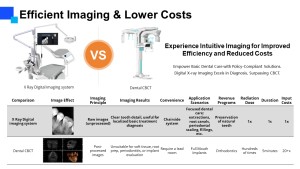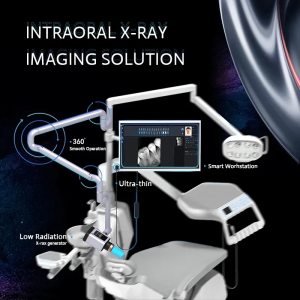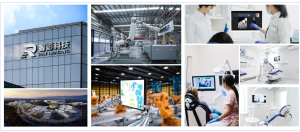The advancement of medical imaging technology has brought new choices to dental diagnosis. Digital X-ray equipment represents one such choice that has emerged, providing alternatives to traditional X-ray machines with advantages like low radiation dose, high image quality, etc.
For dental clinics, oral diagnosis is the foundation of disease treatment. It is very important to choose when facing different X-ray products to select equipment suitable for establishing an accurate diagnosis and creating an optimal treatment plan. Understanding the major differences between the two can help clinics maximize investment.
Understanding Digital X-ray Equipment and Traditional X-ray Equipment
Understanding the definition and working principle of the two helps make an informed decision.
- What is Digital X-ray Equipment?
Digital X-ray machines utilize digital technology instead of film to capture and process images. When the X-rays generated by the generator pass through the oral tissue, they will be converted into electrical signals on the digital sensor. Due to the varying densities of different tissues, the intensity of attenuated X-ray photon signals differs after passing through the oral cavity.
Vivid digital images will be obtained during the processing of the chip inside the sensor. This high-resolution digital X ray image allows dentists to observe various potential issues, reduce misdiagnosis, and increase profits.
- What is Traditional X-ray Equipment?
Traditional X-ray systems are also called film-based X-ray machines. An X-ray tube produces a beam of X-ray that is directed towards the region of the oral, like the teeth or bone. X-rays passing through the oral tissue are then irradiated onto a film, and the photosensitive material on the film undergoes a chemical reaction, forming an image on the film that reflects the internal structure of the oral cavity.
The exposed films are then developed using chemical developers and fixatives to render the latent image visible as a radiograph. Viewing is only possible once traditional wet processing in a darkroom is complete.
What’s the Difference Between Digital X-ray Equipment and Traditional X-ray Equipment?
Understanding key differences between digital and traditional machines can help determine the optimal selection. Here are some main points of comparison:
- Which Machine Provides Higher Image Quality?
Digital X-ray equipment offers sharper contrast and image quality, aiding clearer visualization of fine tooth and bone structures. Digital sensors can also enhance images’ brightness through computer optimization. The image quality of traditional devices may be affected by the film, resulting in overexposure or underexposure, which can affect doctors’ judgment.
- Which Machine has a Lower Radiation Dose?
Digital X-ray machines use highly sensitive sensors to fine-tune radiation exposure precisely according to the situation, minimizing radiation dose without compromising diagnostic value. This enhances doctor’s and patient’s safety over time. Traditional X-ray equipment may require higher radiation doses to make film imaging clearer.
- Which Machine is More Convenient to Operate?
Digital X-ray equipment allows viewing high-quality images immediately on digital imaging workstations, while traditional films require additional development time in a darkroom. Digital workflows are also overall simpler with fewer physical materials. Moreover, it allows imaging again quickly.
- Which Machine has Better Investment Efficiency?
While digital machines involve higher equipment costs, their operational costs are lower in the long term thanks to no film, chemicals, or printing expenses. These film savings provide higher returns on investment over the lifespan of the digital device. Furthermore, this machine can also help check for hidden dental problems, prevent further disease deterioration, and increase clinic profits.
- Which Machine is More Convenient to Manage Data?
Digital files from a digital X-ray machine can easily be archived, retrieved, and electronically transmitted or shared between offices, rather than physical films that require storage space and transport. This boosts data accessibility and collaboration.
Overall, digital X-ray equipment provides image, radiation, workflow, and cost advantages that are important factors for optimizing diagnostics and practice efficiencies in dental clinics. It has gradually replaced traditional X-ray machines as the mainstream in modern dental diagnosis.
Where to Buy Digital X-ray Machines?
When purchasing X ray equipment, you should choose a provider with a strong track record, vast industry experience, and commitment to quality. Ray Imaging Technology is one such recommended brand. Established in 2014, Ray Imaging Technology is a leading manufacturer focused on digital radiography innovations. With our R&D and manufacturing facilities, we push high-voltage generator technology boundaries, providing suitable diagnosis tools for every dentist.
Our eRay DR Imaging System is comprehensive for optimal precision and user-friendly operation. Designed for single-person operation, it provides efficient diagnosis and treatment. Some of its key features include:
- It delivers ultra-low radiation doses during use, meeting stringent safety standards to protect patients and operators.
- User-friendly controls and a versatile robotic arm allow single-handed positioning and operation for enhanced workflow efficiency.
- Its advanced X-ray CMOS digital sensor captures sharp, high-resolution images without omitting every detail.
- Dentists can digitally process, edit, store, and share scans remotely through the product’s intuitive smart system for a fully digital workflow.
- Images appear immediately on-screen for quick and easy viewing, saving time otherwise spent waiting for traditional films.
Conclusion
Regarding digital versus traditional X-ray equipment, digital systems are superior overall as they provide modern conveniences with higher resolution images, lower radiation doses, simplified operations, and efficient data management capabilities. For dental clinics seeking advanced diagnostic tools, the eRay DR Imaging System from Ray Imaging Technology stands out as a reliable and high-performance digital solution that sets new standards for precision and efficiency. Contact us to learn more about it!






